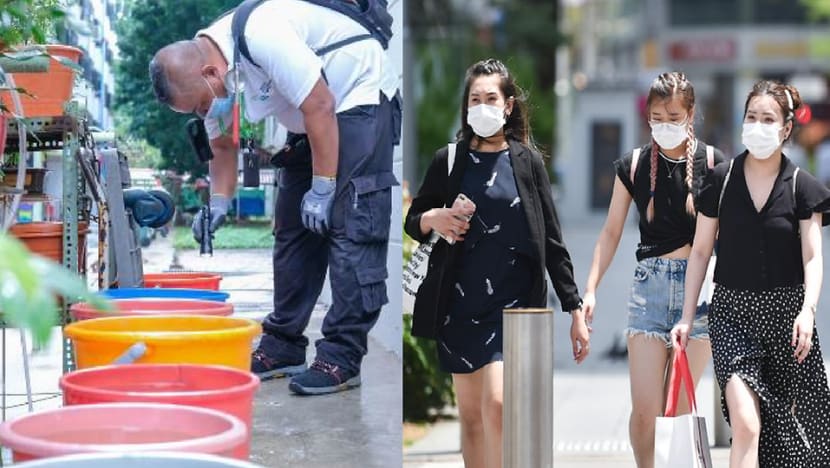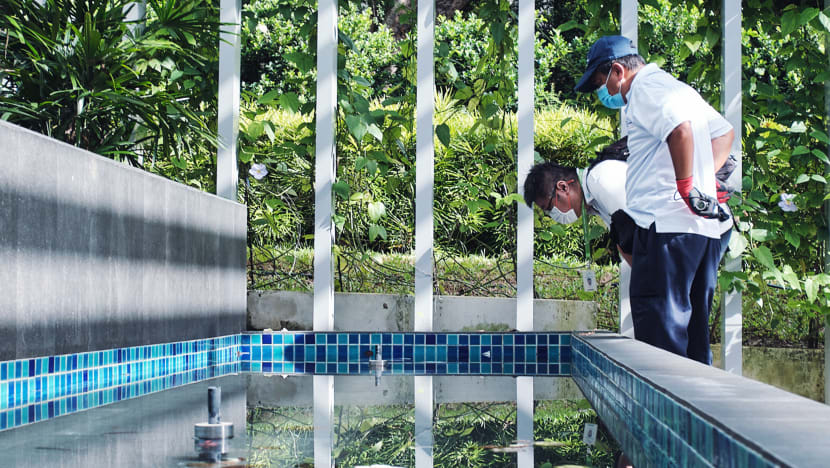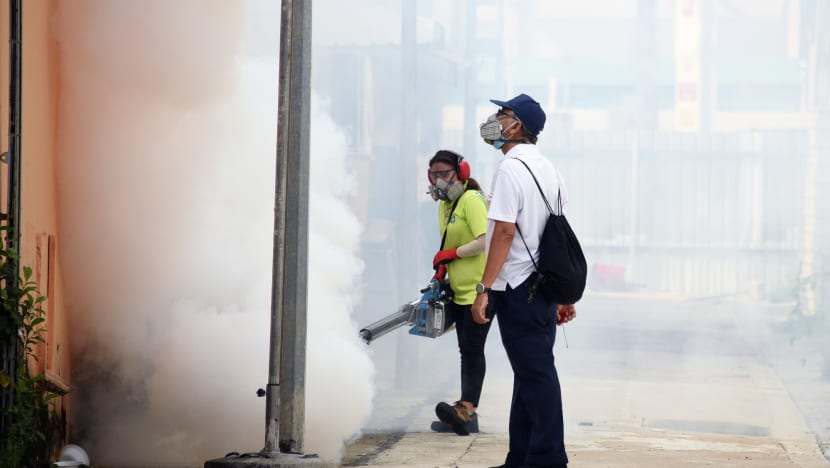commentary Commentary
Commentary: In Singapore, battling the COVID-19 threat outside and the dengue peril at home
Fighting two epidemics at once would threaten even the best healthcare system but small steps can mitigate the threat of dengue, says NUS Saw Swee Hock School of Public Health’s Alex Cook.

Composite photo of NEA officer checking pails of stagnant water and people along Orchard Road. (Photos: National Environment Agency/Gaya Chandramohan)
SINGAPORE: As if COVID-19 was not enough, Singapore is now in the grips of a dengue epidemic of historic proportions.
The lion city started the year with 300 to 400 dengue cases a week, in itself worryingly high, but from May the number of cases has beaten all previous records.
The total number of dengue cases in Singapore also reached a new historic high on Wednesday (Aug 5), at 22,403, surpassing the last record of 22,170 in 2013. More than 1,000 cases have been reported for the past eight consecutive weeks.
The twin epidemics are probably not independent.
READ: Commentary: Burned out while working from home? You should check your work-life boundaries
Never in our lifetimes has humanity done so much to try to prevent a pandemic as we have in the last six months. Lockdowns, circuit breakers, states of disaster — whatever we call enforced physical distancing and time at home — have protected us from the coronavirus, but also radically changed how other diseases spread.
Influenza, for instance, seems to be on the retreat, prevented from spreading with the same drastic reductions in social contacts. But as we spend more time at home, we become exposed to different kinds of health risks, chief among which in Singapore is dengue.
THE RISE OF DENGUE CASES
We lie in a climate that is perfect for the mosquitoes that spread dengue, yet by all indicators, mosquito breeding is low compared to other countries of a similar climate, thanks to one of the world’s best vector control programmes.
Ironically, Singapore’s past successes in vector control makes dengue transmission today much harder to prevent. Two generations ago, pretty much everyone would have had dengue once, maybe twice, during their childhood. Our vector control programmes meant that since the 1970s, in every birth cohort, fewer people were infected.
Today, there is low herd immunity in the population. Our vector control may be as good as ever, but any mosquito that escapes control can pass infection to a greater proportion of the people she bites than was possible 50 years ago.
I call this the Red Queen conundrum: Like Alice in Wonderland, we have to run ever faster just to stay in the same place.

Low herd immunity to dengue is ironically the same problem that has led other countries to experience second waves of COVID-19: In a naïve population, epidemics will grow unless we actively prevent transmission.
As with COVID-19, dengue control is confounded by the large number of undiagnosed infections. Most people infected by the dengue virus may not show severe symptoms, and may decide to sweat it out at home rather than seek medical care. Even those who do seek care may not be diagnosed as having dengue.
Such missed infections are critical, because people with mild infections may still spread the virus to mosquitos. Yet, by being hidden, they do not count towards clusters or trigger response.
Exactly how many infections are missed is hard to measure but past studies of blood from blood donors suggest the majority of dengue infections in Singapore are not diagnosed.
Might the COVID-19 pandemic have changed the chances of dengue diagnosis? It is too early to have scientific evidence to support this, but I suspect a greater percentage of our dengue infections are being diagnosed this year, because of better health-seeking behaviour on the part of those who are unwell and more widespread testing by doctors.
But while we cannot be sure whether this year’s dengue outbreak is worse than previous epidemics, the current situation is unarguably bad.
READ: Commentary: Making a trip to the clinic is not the only way to get medical treatment during COVID-19
READ: Commentary: Is swine flu going to be the next pandemic?
WE NEED A MIX OF PUBLIC HEALTH MEASURES
Fighting two epidemics at once would threaten even the best healthcare system. What then can we do to stop this?
In preventing dengue epidemics, we face the same problem as with COVID-19: The lack of an effective vaccine means we need to control outbreaks through public health measures.
In the next few years, NEA’s new technology of Wolbachia-infected mosquitoes may fundamentally change how we respond to outbreaks of dengue.
Release of these mosquitoes (which are male, so they do not bite) in pilot studies in Nee Soon and Tampines have shown impressive reductions in the wild mosquito population. While the pilots have yielded valuable insights on how to deploy the technology efficiently, the scale has not yet reached the level that would lead to reductions in incidence of disease in people.

That may change soon though, as production ramps up at the new plant in Ang Mo Kio. This may not be in time for the current outbreak, but the technology could prevent an outbreak of a similar size from happening again.
A COMMUNITY RESPONSE IS ALSO NEEDED
We ought, however, to move away from thinking of dengue as being a problem for the Government to sort out, and towards a social response to this threat.
What can we do to protect our families from dengue? There are three main actions we can take today.
First, know the risk. Is your home, your work, or your children’s school near a cluster? Is there mosquito breeding there?
You can find out from the myENV app, which has up-to-date information on dengue clusters and breeding. Save the address of important places and you can find out when the risk rises.
Second, reduce exposure. If you or your family are going near a cluster, wear long sleeves and pants, and apply mosquito repellent. If you live in a cluster, consider doing this even at home, until the epidemic abates.
Third, stop breeding around the home. We all know the Mozzie Wipeout and should be doing this routinely.
READ: Commentary: The lower immunity behind the current dengue outbreak
READ: Commentary: Record dengue cases complicates Singapore's fight against COVID-19
You can also make your home less hospitable for mosquitoes by spraying insecticide in the dark spaces the female likes to rest in after a blood meal - especially behind curtains, under sofas and tables, and in dark corners of the kitchen. Do that away from food.
Give a covering to surfaces using a can of insecticide spray you can get in the supermarket. Insecticide spraying is recommended by NEA to help prevent infection around your home.
The twin epidemics of COVID-19 and dengue impose an unparalleled public health threat. The thought that another community wave of COVID-19 might coincide with our hospitals being full of dengue patients is chilling, yet this risk could easily come to pass without urgent action from us all.
LISTEN: The COVID-19 vaccine will be the biggest product launch in history. Can we pull it off?
BOOKMARK THIS: Our comprehensive coverage of the novel coronavirus and its developments
Download our app or subscribe to our Telegram channel for the latest updates on the coronavirus outbreak: https://cna.asia/telegram
Alex R Cook in an associate professor who leads the Biostatistics and Modelling Domain and serves as the vice dean of research at the same school.














